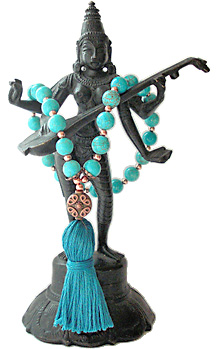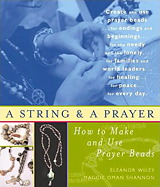Traditionally, prayer beads have consisted of strings of similarly sized beads, seeds, knots, or even rose petals and beads made from crushed roses, from which we get the word "rosary." The Sanskrit term japa mala means "muttering chaplet," which refers to prayer beads' function as a means of recording the number of prayers uttered. Since counting prayers was initially so important, each religion embracing the use of prayer beads developed its own symbolic structure to follow.
In addition to helping keep one's place in structured prayers, prayer beads also symbolize the commitment to spiritual life. With their circular form, a string represents the interconnectedness of all who pray. Each bead counted is an individual prayer or mantra, and the rote repetition of prayers and mantras is meant to facilitate a sole focus on the prayer or mantra itself.
Religious Use of Beads » History of Prayer Beads » A String & A Prayer: How to Make & Use Prayer Beads
Eleanor Wiley and Maggie Oman Shannon (2007) Red Wheel/Weiser, LLC




